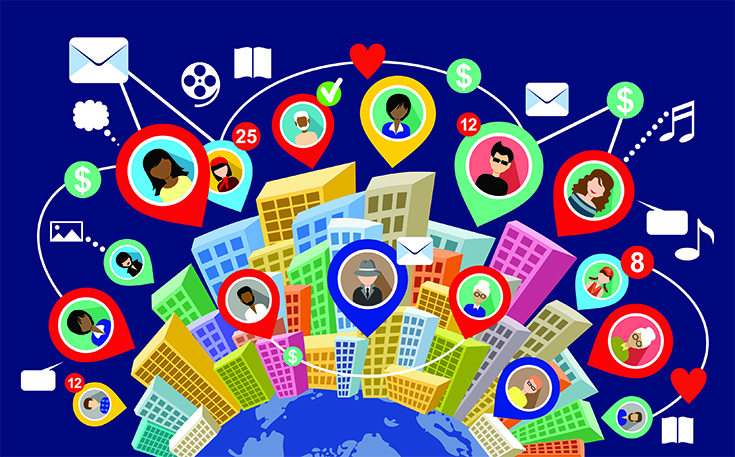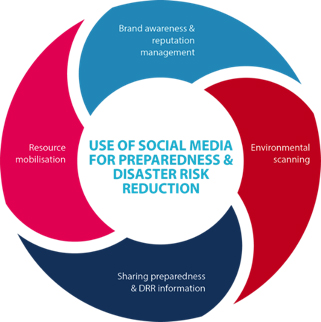Facilitating two-way public communication in crisis and disaster management
Susan Anson, Katrina Petersen and Hayley Watson outline several projects in which Trilateral Research – together with partners – has been examining the role communication, and particularly two-way communication, plays in crisis and disaster management

Social media communication is not just one-way – communities can take action and be active participants rather than passive listeners (Nataliya Yakovleva/123rf)
The use of social media platforms and contemporary ICT technology has radically changed the way we prepare communities and support them in responding to crises and disasters. One-way communication is no longer enough. We use contemporary technologies to create awareness but, more importantly, we can encourage and support communities to take action, relating to the audience as active participants instead of passive listeners, as they provide feedback and insights of their own, alongside receiving new information and vital instructions.
Effective crisis and disaster management relies on achieving specific communication goals, such as:
-
Encouraging specific community responses;
-
Speaking to individual people that need to make life or death decisions;
-
Getting a new perspective heard; and
-
Ensuring public safety.
However, these goals can only be successfully achieved with a full understanding of the dynamics within communication contexts and specific cultural backgrounds. For example, by considering elements such as:
-
Decision-making processes;
-
Political structures;
-
Terminologies;
-
Physical environments;
-
Value systems; and
-
Socio-economic challenges.
This increased focus on participatory communication means that sharing information is no longer just about ensuring content reaches an audience, but also involves the ethical and social responsibilities of an organisation when communicating with fellow responders and the public. Organisations not only need to provide accurate information, but also must consider the cultural context in order to build trust and maintain legitimacy by gaining insights into why the audiences would want to listen, why they would want to take the time to understand, and how they might be willing to act and respond to the information.
Trilateral Research examined the use of social media and of new communication technologies (the web and mobile telephony for example) and applications (eg social networks such as Twitter and Facebook) throughout all phases of the crisis and disaster management cycle. It partners with other organisations to create new technological solutions that enable citizens to report threats to safety, triggering an immediate and more effective response on the authorities’ behalf. It has also examined the risks in the use of new technologies and how to respond to misinformation, rumours, and new social expectations of a speedy delivery in terms of communication and the crisis response.
Trilateral’s user-centric approach, which is key to creating two-way communication solutions, affords the opportunity to carry out early assessments of ethical and privacy issues, addressing security and the requirement for responsible use during the technology development process.
Communication for preparedness and disaster risk reduction
As part of the PREP1 project (2017), funded by Elrha’s Humanitarian Innovation Fund, Trilateral worked with Red Cross Red Crescent (RCRC) national societies, with the support of the International Federation of the Red Cross, to identify four uses of social media.

Social media enables RCRC actors to engage in two-way communication with the community to promote its brand and secure its reputation, for example, by mitigating any rumours
Social media can also be used for identifying potential risks through environmental scanning activities, such as identifying real-time events such as a flood) and communicating safety information.
Alternatively, social media can be used as a form of one-way communication for sharing context-specific disaster preparedness and disaster risk reduction information. Such a measure can be used for long-term preparedness activities – for example, ongoing earthquake preparedness activities in California – as well as for short-term preparedness activities such as storm warnings and the importance of flood defences and other awareness-raising activities.
This is important for raising awareness of measures that individuals and organisations can take to improve their own resilience to potential crises. For instance, in the lead-up and during the events of Cyclone Debbie in April 2017, the Australian Red Cross posted about weather updates, the availability of shelters, advice on coping and clean-up advice.
Lastly, social media was found to be effective in communicating with the wider community to raise funds and other resources in the wake of a disaster.
This use of both one-way and two-way communication through social media creates an overall environment in which the care provided by the RCRC can be tailored to the community at hand, resulting in greater effectiveness.
Communication for crisis response
The EC funded Cosmic (The COntribution of Social Media In Crisis management) project (2013-2015), provides many lessons on how new communication technologies – the web, mobile telephony – and applications – social networking applications such as Twitter and Facebook, for example – are being used in crisis response.
Trilateral’s role on the Cosmic project involved examining the multiple applications of communication technologies in supporting crisis response, including:
One-way communication (notify/alert);
Two-way communication (converse/provide feedback);
Request/offer assistance;
Relay (share a piece of information with others);
Campaign (awareness raising/fund raising); and
Organise (co-ordinate response/enable individuals to organise themselves).
Researchers found that only seven out of 31 media applications – Twitter, Facebook, Google+, YouTube, Reddit, blog posts, Ubalert – enabled two-way communication by facilitating discussion, the exchange of information, the sharing of content, and instant messaging.
By pairing two-way media with more traditional communication channels for sending alerts, it is possible to create calls to action that can be shared more effectively. Additionally, by considering both the desired public response and how the public reacts to these requests, it is possible to tailor messages and how they are delivered to better effect.
New interactive communication solutions to tackle threats to public safety
The findings of Cosmic and PREP1 show us how the same communication channel – social media – can play a similar role during both the preparedness and response phases.
This is particularly evident in the EC funded Inspec2t (Inspiring CitizeNS Participation for Enhanced Community PoliCing AcTions) project (2015-2018) where partners are developing technical solutions for Community Policing that can be used by communities and police before, during, and after a crisis.
The Inspec2t solution will enable two-way communication between communities and the police and allow citizens to report crime, disorder and threats to safety. Integral to Inspec2t is the project’s user-centric design approach that enabled ethics and privacy principles such as informed consent to be considered during technology development. Considering two-way communication within the design process increases both security and the potential for responsible use.
The importance of contexts and standards for better communication practices
During the EC funded TACTIC (Tools, methods And training for CommuniTIes and society to better prepare for a Crisis) project (2014-2016), researchers understood how preparedness strategies should actively engage with public perceptions and understandings of risk.
TACTIC developed self-assessment tools, considering both communication strategies and the wider communication context, to support organisations in the analysis of their risk communication practices, assessing its effectiveness, and room for improvement.
For the assessment to be effective, TACTIC’s partners included questions about the wider context in which the communications take place; for example, about the organisation’s experience and perception of the hazard, experience in cross-border communication and the organisation’s existing risk communication strategy, including:
-
Available resources;
-
Perceptions of whether the general public trusts the organisation’s communications;
-
The approach and communication channels used;
-
The use of feedback to improve the strategy; and
-
The aims of the strategy.
-
The assessment tool is two-way: it includes a self-assessment for the general public to understand its preparedness and information needs, and the results are shared with organisations in order to feed into their risk communication strategies.
This research has found that a further approach to enhance communication practices is through standardisation. Providing standardised information during a disaster, including having a common language for warning and standard messages to provide information to citizens, have been identified as key standardisation needs by partners involved in the EC funded ResiStand (Increasing disaster Resilience by establishing a sustainable process to support Standardisation of technologies and services) project (2016-2018).
For further details, contact Trilateral Research
Sources
Watson, H, Finn, R, Wadhwa, K, Yannopoulos, A: Baseline analysis of communication technologies and their applications, Deliverable 2.1 of the COSMIC project, August 2013
Papadimitriou, A, Yannopoulos, A, Kotsiopoulos, I, Finn, R L, Watson, H, Wadhwa, K, Baruh, L: Case studies of communication media and their use in crisis situations, Deliverable 2.2 of the COSMIC project, September 2013.
Hayley Watson, Susan Anson, 02/12/2017